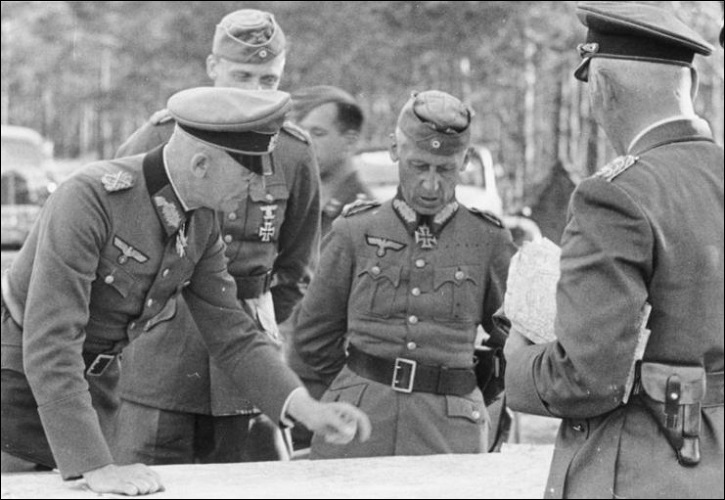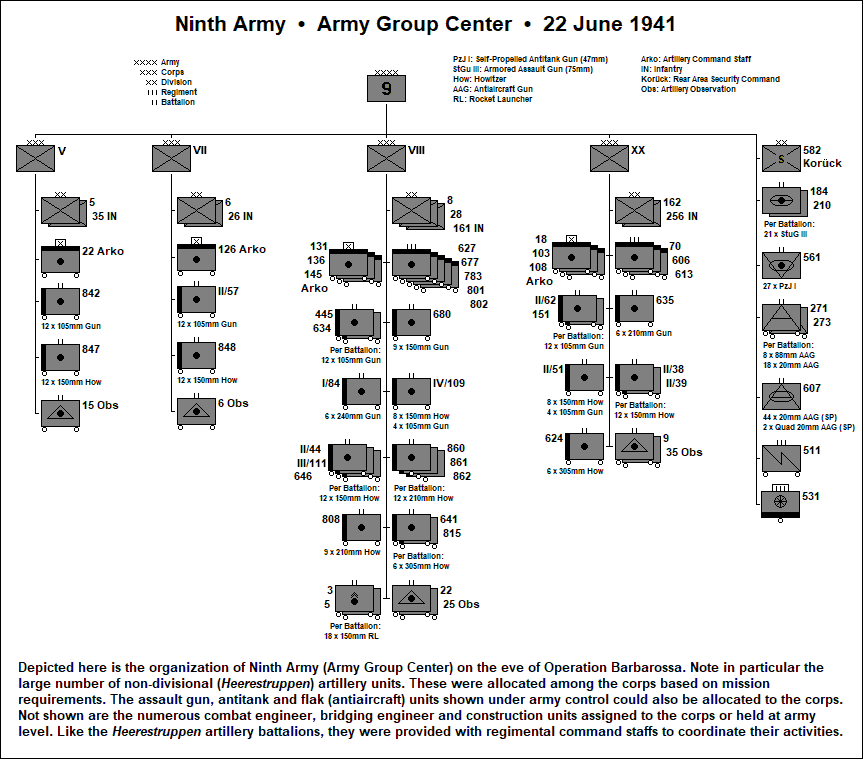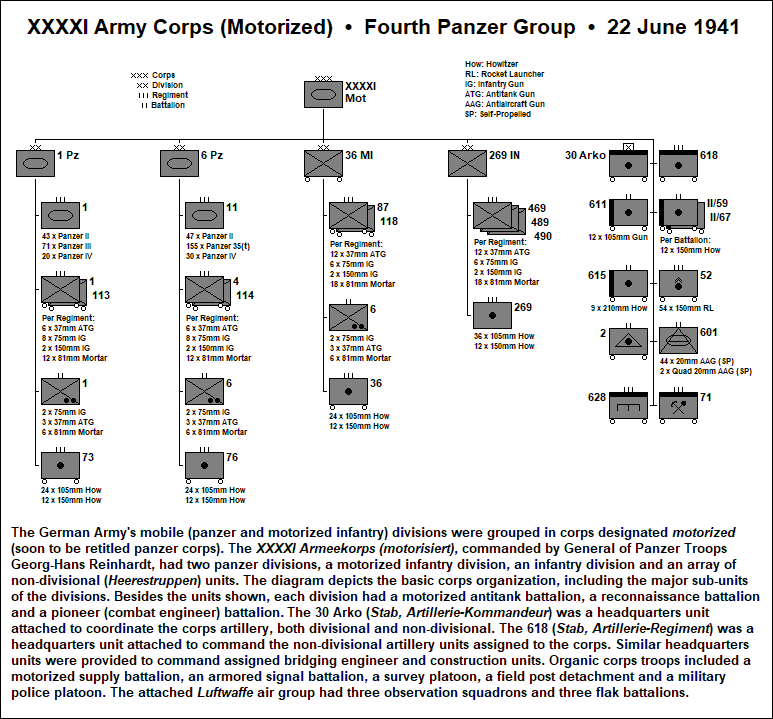The German Army's highest field
command was the Heeresgruppe
(army group), here abbreviated to HG. They usually
had a geographical designation, e.g. HG Nord (North)
or an identifying letter, e.g. HG A. Then came the
numbered field armies, e.g. 6. Armee (Sixth Army),
and the panzer groups, e.g. 1. Panzergruppe (First
Panzer Group). The next echelon of command was the
Armeekorps (corps), identified by Roman
numerals, e.g. XXVI. Armeekorps. Corps commanding
armored and motorized units included the designation
motorisiert (motorized) in their titles, e.g. LVII.
Armeekorps (motorisiert). The Höhere Kommando
(corps command) was a reduced-strength corps headquarters
employed for special purposes; e.g. LXX. Höhere Kommando.
Sometimes the designation zur besonderer Verwendung
(for special service) was included, e.g. LXV. Höhere
Kommando zbV. Divisions were numbered and bore
functional titles, e.g. 4. Infanterie-Division, 12.
Panzer-Division, etc. There were also two temporary
command arrangements for special missions or emergencies.
The Armeeabteilung (army detachment) placed one corps
in command of a second corps; the Armeegruppe placed
one field army in command of another. They were usually
named after their commander, e.g. Armeeabteilung Kempf,
or received a letter designation, e.g. Armeegruppe G.
The “L” designation applied to 37mm
and larger tank guns indicated barrel length; the longer the
barrel the higher the muzzle velocity of the gun and the
greater its ability to penetrate armor.
● ● ●
For the invasion of the USSR, the
German Army was deployed in three Heeresgruppen. In East Prussia HG Nord
(North), Field Marshal Wilhelm
Ritter von Leeb
commanding, had two field armies and one panzer
group poised to advance on Leningrad through the Baltic
states. In the northern part of German-occupied Poland HG
Mitte (Center), Field Marshal Fedor von Bock commanding,
had two field armies and two panzer groups standing in
readiness to advance on Moscow via Minsk and Smolensk.
Farther south in occupied Poland HG Süd (South),
Field Marshal Gerd von Rundstedt commanding, had two field
armies and one panzer group prepared to advance into the
Ukraine with Kiev and the resource-rich Donets Basin as its
objectives. In Romania, a German-Romanian army group
nominally under the command of Marshal Ion Antonescu was
ready to advance along the Black Sea coast with Odessa and
the Dnieper River line as its immediate objectives.
The German field armies each had
three or four corps under command, each corps with between
two and four divisions. The panzer groups were armies in
effect, with two to four motorized corps under command. But
military conservatism withheld from them the designation
army, which would have endowed their commanders with the
title Oberbefelshaber
(commander-in-chief) rather than just Befelshaber
(commander).
The 9.
Armee (HG Mitte)
was typical of the field armies deployed against the USSR.
Commanded by Colonel-General Adolf Strauss, it had four
corps and nine
infantry divisions plus an array of
non-divisional combat, service, construction and labor
units. Most of the non-divisional units (Heerestruppen)
were under the corps rather than the army headquarters; for
instance, VIII. Armeekorps had in addition to its three infantry
divisions no fewer than fourteen medium and heavy artillery
battalions. An
attached Kommandeur der Luftwaffe controlled an air
group providing the army with short-range reconnaissance,
observation, liaison, courier and flak (antiaircraft)
support.
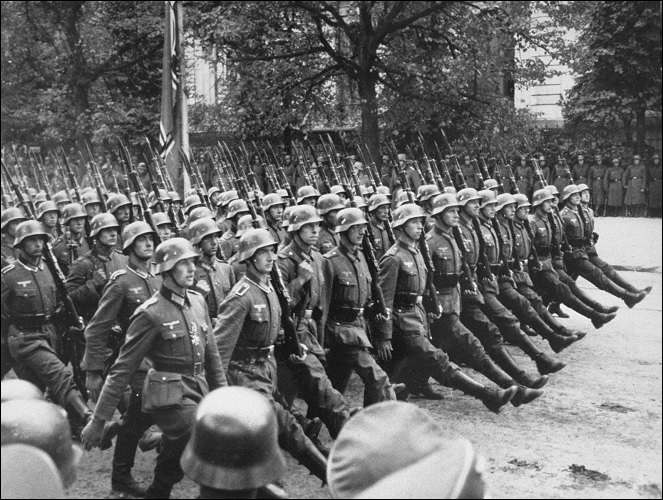
Infantry of
the
German Army on parade in the spring of 1941. (Photo:
Bundesarchiv)
Of the major motorized formations,
1. Panzergruppe (HG Süd) was typical. Commanded by
Colonel-General Paul Ludwig Ewald von Kleist, it had three
motorized corps, five
panzer divisions, four
motorized
infantry divisions (two Army, two
Waffen-SS)
and one infantry division. Three of the motorized infantry
divisions were held under control of the group headquarters,
but as with the field armies most Heerestruppen units
were assigned to the corps. XXXXVIII. Armeekorps (motorisiert),
for
example, had in addition to its two panzer divisions six
medium and heavy artillery battalions, three rocket
artillery battalions, a self-propelled antitank battalion
and two light flak battalions. The usual service units and Luftwaffe air group were also present.
In round numbers the German Army
committed 154 divisions to Operation Barbarossa. Of them,
104 infantry, nineteen panzer, fifteen motorized infantry,
one cavalry and nine security divisions were in the three
army groups. Another four infantry divisions were deployed
in northern Finland and two were held in OKH reserve. One of
the infantry and four of the motorized infantry divisions
were Waffen-SS formations. The German panzer divisions
fielded around 3,500 tanks, some of which were light and
some were of Czech origin.
Each army group had an air fleet (Luftflotte)
in support. Luftflotte 2,
assigned to HG Mitte, was the strongest of
them. Commanded by Field Marshal Albert Kesselring, it had
two air corps (Fliegerkorps) controlling four
fighter, one fighter-bomber, three medium bomber and three
dive bomber groups—each group with between 90 and 120
aircraft. There were also several reconnaissance and
transport squadrons, plus a flak corps controlling six
battalions of light and heavy antiaircraft guns.
In terms of troops provided,
Romania and Finland were Germany’s major allies against the
USSR. Both countries harbored legitimate grievances against
the Soviet colossus. By the terms of the treaty ending the
1939-40 Winter War, Finland had been forced to cede a large
part of its province of Karelia and
various other territories to the USSR. Romania, faced with a
Soviet ultimatum in July 1940, had been compelled to yield
up its province of Bessarabia. Both countries now
aspired to regain their lost territories by allying with
Germany, though Finland styled itself a “co-belligerent”
rather than a formal ally. The lightly equipped but
well-trained and experienced Finnish Army was fourteen
divisions strong; the initial Romanian contribution
totaled around fifteen infantry divisions and cavalry
brigades of varying strength and quality.
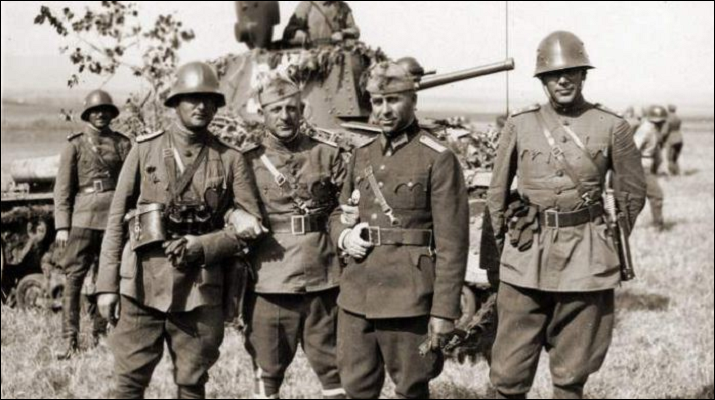
A group of Romanian Army
officers in the USSR, summer 1941 (World War Photos)
Other German allies were Hungary,
which without much show of enthusiasm contributed its
Carpathian Army Group (actual strength about two and a half
divisions) and the puppet state of Slovakia, whose
Expeditionary Army Group embodied two infantry divisions and
a motorized brigade. In August, the Italian Expeditionary
Corps (Corpo di Spedizione Italiano) with two
motorized infantry divisions and a cavalry division would
join HG Süd.
In general, the German infantry
divisions committed to Barbarossa were in good fighting
trim. The campaigns in Poland, Scandinavia and northwest
Europe had not been too costly and the lull following the
fall of France gave time for some of the Army’s deficiencies
to be made up. Most of the infantry divisions were at full
strength or close to it, though it had not proved possible
fully to standardize their organization. A fair number, for
instance, had no reconnaissance battalion, having to make do
with a single bicycle infantry company. Divisions of the 3rd
and 6th
Waves had captured Czech 155mm heavy howitzers in place of
the standard German 150mm model. Four divisions of the 12th
Wave were designated as Jäger-Divisionen
(light divisions); they had a special two-regiment
organization and a higher level of motorization than
the standard infantry division. The several
Gebirgsjäger-Divisionen (mountain infantry divisions)
also had a special organization. Divisions of the 13th and
later Waves were not committed to Barbarossa. Most of them
were significantly lower in strength and largely equipped
with captured weapons and vehicles. The nine security divisions
were second-line formations, mostly converted from regular
infantry divisions.
They were configured for occupation duties
and anti-partisan operations in the rear of the field
forces.
As for the mobile forces, after the
French campaign Hitler had decreed a doubling of the number
of panzer divisions, from ten to twenty. This, however,
necessitated a reduction in their authorized tank strength,
since industry could not produce tanks in sufficient numbers. The Army was also compelled to keep large numbers
of ex-Czech tanks in service with six of the panzer
divisions, even though they were considered obsolescent by
1941. Seven divisions
still had some Panzer I light tanks, armed only with machine
guns (MG) and useless for any purpose but reconnaissance.
Panzer divisions equipped with
German tanks mostly had a panzer regiment of two battalions with an
authorized total of 134 gun-armed tanks. The 1. Panzer-Division, for instance, had 43 x Panzer II (20mm gun), 71 x
Panzer III (50mm/L42 gun) and 20 x Panzer IV (75mm/L24 gun).
But numbers and tank types could vary.
The 9. Panzer-Division had 131 tanks: 8 x Panzer I (twin MG
only), 32 x Panzer II, 11 x Panzer III (37mm/L46 gun), 60 x
Panzer III (50mm/L42 gun) and 20 x Panzer IV.
Divisions with Czech tanks has a regiment of three
battalions, for example the 8. Panzer-Division with 191
tanks: 49 x Panzer II, 118 x Panzer 38(t) (37mm/L48 gun) and
30 x Panzer IV. The usual number of Czech
tanks was 110-120 per division but two had more: 155
in the 6th Panzer Division and 167 in the 7th Panzer
Division.
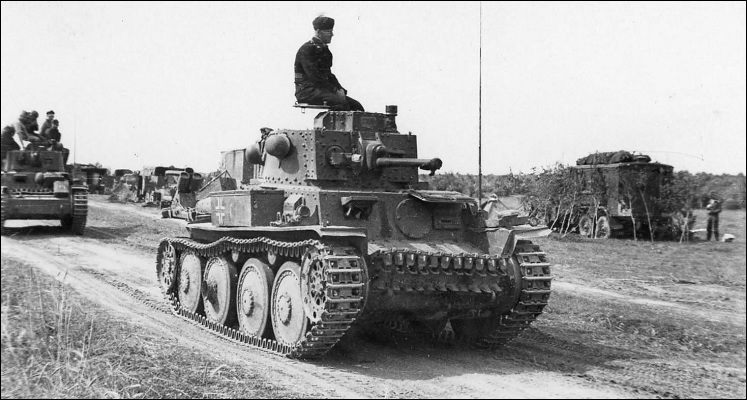
Panzer 38(t) tanks of the
12th Panzer Division on the move in the USSR, Summer 1941 (Bundesarchiv)
Thus in reality no two panzer
divisions were exactly alike. Both the Panzer II and Panzer
IV
were in particularly short supply, and for the former the thoroughly obsolete
Panzer I was substituted. The panzer battalion was supposed
to have one medium company with 14 x Panzer IV, but in many
cases one platoon (four tanks) had to be deleted. In theory,
all Panzer IIIs should have been armed with the 50mm gun but
thanks to the usual production bottlenecks
earlier models with the 37mm gun were
still present in nine divisions. In addition to gun-armed
tanks, all divisions had 10-15
command tanks (Panzerbefehlswagen).
These were a variants of the Panzer I and Panzer III with extra radio equipment,
armed with one MG only.
The panzer divisions
had two motorized infantry regiments, each with two
battalions, one of which was supposed to be a "panzer
grenadier" battalion with armored halftracks instead of
trucks, but only the 1. Panzer-Division had two
battalions so equipped. The 10. Panzer-Division had one panzer grenadier battalion and the others
had only a single company with halftracks or, in a couple of
cases, none at all.
The
Führer had also ordered the number of motorized
infantry divisions to be doubled, but here again industry
was unable to produce military trucks in sufficient numbers.
The Army was therefore compelled to press large numbers of
requisitioned civilian and captured trucks into service,
notwithstanding the performance and maintenance
penalties involved. Four divisions could not be provided
with a light flak company and two lacked the motorcycle
platoons that should have been present in the infantry
regiments.
It was true that in some ways the firepower of
the panzer and motorized infantry divisions had been
improved. The panzer divisions now had more gun-armed Panzer III and
IV tanks, and all had finally received a medium
artillery battalion with 12 x 150mm howitzers. Most of the
divisional antitank battalions had received an allotment of
the new 50mm antitank gun, augmenting the inadequate 37mm ATG.
But even so, the overall combat capability of the mobile
divisions was somewhat less than it had been a year earlier.
Their real margin of superiority over the
new enemy lay in the areas of training, experience,
leadership and superior staff work.
Yet even allowing for all the
lingering deficiencies that beset the German Army, the first day of Operation Barbarossa, 22 June 1941, was
its high-water
mark. Never again would the Army achieve the peak of strength,
readiness and confidence with which it went forward into
battle against an enemy who would prove far more formidable than any it had
yet encountered.
(See Dr. Leo
Niehorster's website, World War II Armed
Forces, for detailed Barbarossa orders of battle,
German
and
Soviet.)
● ● ●
